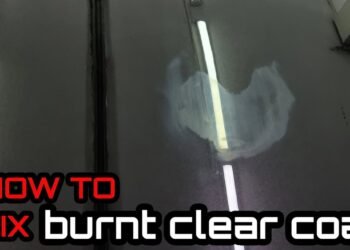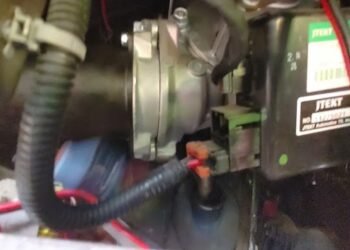Have you ever noticed an unexpected splash of nail polish on your car’s paint and felt that sinking feeling? It’s frustrating to see your vehicle’s flawless finish marred by stubborn stains.
But don’t worry—removing nail polish from your car paint is easier than you think. With the right approach and simple household items, you can restore your car’s shine without damaging the surface. Keep reading, and you’ll discover step-by-step tips that will help you safely and effectively get rid of that pesky polish, protecting your investment and keeping your ride looking its best.
Assess The Stain
Before removing nail polish from car paint, carefully assess the stain. Understanding the type of polish and the paint’s condition helps choose the safest method. This step prevents damage and ensures effective cleaning.
Take your time to inspect the stain closely. Look for size, color, and texture differences. These clues reveal how the polish interacts with the car’s surface. Proper assessment leads to better removal results.
Identify The Nail Polish Type
Check if the nail polish is regular or gel-based. Regular polish is thinner and dries faster. Gel polish is thicker and harder to remove. Knowing this helps select the right solvent.
Also, note the color of the polish. Dark colors may leave stains more easily. Light colors might be less visible but still require careful removal. This step avoids spreading the stain.
Check Paint Condition
Examine the car paint around the stain. Look for scratches, chips, or fading. Damaged paint needs gentle cleaning methods to avoid worsening the problem.
Test the stain area by touching it gently. If the paint feels rough or fragile, avoid harsh chemicals. Use mild cleaners and soft cloths to protect the finish. This ensures your car’s paint stays intact during cleaning.

Credit: dentgoalie.com
Gather Cleaning Supplies
Gathering the right cleaning supplies is the first step to remove nail polish from car paint safely. Using proper tools helps avoid damage to the car’s finish. Prepare all items before starting the cleaning process. This saves time and makes the job easier.
Microfiber Cloths And Cotton Balls
Microfiber cloths are soft and gentle on car paint. They prevent scratches while cleaning nail polish. Use clean, dry microfiber cloths for best results. Cotton balls work well for applying liquids. They absorb nail polish remover evenly. Choose fresh cotton balls to avoid spreading dirt.
Rubbing Alcohol And Citrus-based Removers
Rubbing alcohol breaks down nail polish without harsh chemicals. Apply it on a microfiber cloth and gently rub the affected area. Citrus-based removers are natural and less aggressive. They help lift nail polish safely from the paint surface. Both options are good for delicate cleaning tasks.
Non-acetone And Acetone Nail Polish Removers
Non-acetone removers are mild and less likely to damage paint. Use them first to test the reaction on a small spot. Acetone removers are stronger and remove tough polish quickly. Use acetone carefully and sparingly. Always test on an inconspicuous area to avoid damage.
Prepare The Car Surface
Preparing the car surface is essential before removing nail polish from the paint. This step helps avoid further damage and ensures better cleaning results. Clean and dry surfaces allow the remover to work effectively. Follow these simple steps to get your car ready.
Wash With Car Soap And Water
Use a mild car soap and clean water to wash the affected area. This removes dirt, dust, and oils that can interfere with the cleaning process. Gently scrub with a soft sponge or cloth. Avoid harsh scrubbing that can scratch the paint. Rinse thoroughly to remove all soap residues.
Dry The Area Thoroughly
After washing, dry the surface completely using a clean microfiber towel. Moisture can reduce the effectiveness of nail polish removers. Drying also prevents water spots or streaks. Make sure no water remains in cracks or crevices around the stained spot. The surface must be dry for the next steps.

Credit: www.youtube.com
Test Cleaning Products Safely
Testing cleaning products safely is vital before removing nail polish from car paint. Some chemicals can damage your car’s finish. Always check how the product reacts on a small, hidden area first. This step prevents costly mistakes and keeps your paint intact.
Choose An Inconspicuous Spot
Find a hidden area on your car to test the cleaner. This spot could be inside the wheel well or under the door handle. Apply a small amount of the product there. Watch for any changes in color or texture for a few minutes. If the paint looks fine, the product is safe to use.
Apply Small Amounts Carefully
Use a cotton ball or soft cloth to apply the cleaner. Dab only a tiny amount at first. Gently rub the nail polish stain without pressing hard. Avoid soaking the paint with liquid. Wipe off the area quickly and check if the polish lifts. Stop immediately if the paint starts to dull or peel.
Remove Nail Polish Gently
Removing nail polish from car paint requires a gentle approach to avoid damage. Harsh chemicals can ruin the clear coat and paint underneath. Start with mild solutions and work carefully to lift the polish without scrubbing hard.
Always test any remover on a hidden spot first. This step helps ensure the product will not harm your car’s finish. Use soft cloths or cotton balls to apply cleaners and wipe gently. Follow up by cleaning the area with soap and water to protect the paint.
Use Rubbing Alcohol First
Rubbing alcohol is mild and often effective on nail polish stains. Dampen a microfiber cloth with alcohol. Lightly rub the nail polish spot in small circles. Avoid soaking the area. Alcohol evaporates quickly and is less likely to damage paint.
Try Citrus-based Adhesive Remover
Citrus-based removers break down sticky substances without strong chemicals. Apply a small amount on a clean cloth. Gently rub the nail polish stain. These removers are safer for car paint than acetone or harsh solvents.
Apply Non-acetone Remover If Needed
Non-acetone nail polish removers are less aggressive. Use them only if alcohol and citrus products fail. Test a tiny area first. Dab a cotton ball with remover and softly wipe the polish. Do not let it sit too long on the paint.
Use Acetone With Caution
Acetone is very strong and can damage car paint quickly. Only use as a last resort. Test on an unseen spot before applying. Apply with a cotton swab, not a cloth. Wipe the polish gently and rinse the area immediately. Always wash and wax the spot after treatment.
Clean And Rinse The Area
After removing nail polish from your car’s paint, cleaning and rinsing the area is crucial. This step removes leftover residue that can harm the paint. It also prepares the surface for drying and further protection. Proper cleaning keeps your car’s finish smooth and shiny.
Wash Off Residue With Soap And Water
Use a mild car soap mixed with water. Dip a clean sponge or cloth into the soapy water. Gently wash the treated area to remove any leftover chemicals or polish bits. Avoid scrubbing hard to prevent paint damage. Rinse the area with clean water to remove soap and debris. This step ensures no harmful residue stays on the paint.
Dry The Surface Properly
Use a soft microfiber towel to dry the area. Pat the surface gently to avoid scratching. Make sure the paint is completely dry before applying wax or sealant. Drying prevents water spots and helps maintain the car’s shine. Proper drying protects the paint from future damage and keeps it looking fresh.
Restore Paint Shine
Restoring the shine of your car’s paint after removing nail polish is vital. Nail polish can dull the finish and leave stubborn spots. Proper care helps bring back the original gloss and protects your paint from damage.
Follow these simple steps to restore your car’s paint shine effectively and safely.
Apply Clear Nail Polish To Soften Stubborn Spots
Use clear nail polish to soften nail polish stains on your car paint. Apply a thin layer over the affected area. Let it sit for a few minutes. This helps loosen the dried nail polish for easier removal. Wipe gently with a soft cloth. Repeat if necessary, but avoid scrubbing hard to prevent paint scratches.
Use Automotive Polishing Compound
After removing nail polish, use an automotive polishing compound. It removes dullness and light scratches from your paint. Apply a small amount to a clean, soft cloth. Rub the compound on the surface in small, circular motions. This restores the smoothness and shine of the paint. Buff the area until it looks glossy and even.
Finish With Wax Or Paint Sealant
Protect the restored shine by applying wax or paint sealant. Wax adds a protective layer and enhances gloss. Paint sealants offer longer-lasting protection against dirt and UV rays. Use a clean applicator pad to spread wax or sealant evenly. Allow it to dry as per product instructions. Finally, buff with a soft cloth for a smooth, shiny finish.
Prevent Future Stains
Preventing future stains on your car’s paint helps keep it looking fresh and clean. Nail polish stains can be tough to remove and may damage the paint if left too long. Taking simple steps regularly can protect your car from these unwanted marks. Consistent care is the key to maintaining your car’s beauty and value.
Regular Car Washing
Washing your car regularly removes dirt and contaminants that can harm the paint. Use gentle car soap and soft cloths to avoid scratches. Clean surfaces create less chance for stains to stick. Make washing your car a routine to keep its shine and prevent buildup.
Prompt Spot Cleaning
Clean any spills or stains immediately after they happen. Nail polish and other chemicals can damage paint if left too long. Use a microfiber cloth with mild cleaner to remove spots gently. Quick action reduces the risk of permanent stains and paint damage.
When To Seek Professional Help
Knowing when to seek professional help is important if nail polish stains your car paint. Some problems need expert care to avoid further damage. Professionals have the right tools and skills to restore your car’s finish safely. Ignoring serious issues may lead to costly repairs or permanent damage.
Extensive Paint Damage
Large or deep paint damage needs professional attention. Nail polish can sometimes cause the clear coat to peel or bubble. If you see cracks, chips, or large areas affected, do not try to fix it yourself. Experts can assess the damage and decide on the best repair method. They use special products to protect and restore your car’s paint.
Persistent Stains
Stains that do not come off with home treatments require expert help. Nail polish contains strong chemicals that may leave tough marks. Professionals use safe, stronger solvents and tools to remove these stains. They also prevent harm to the paint during cleaning. Persistent stains can ruin your car’s look, so timely professional care is necessary.

Credit: www.reddit.com
Frequently Asked Questions
How To Get Nail Polish Off Of Car Paint?
Apply rubbing alcohol or citrus-based remover on a microfiber cloth. Gently rub the nail polish. Test acetone on a hidden spot, then carefully use it if needed. Wash with soap and water afterward. Finish by applying wax or sealant to protect the paint.
Will Fingernail Polish Remover Damage Car Paint?
Nail polish remover, especially acetone-based, can damage car paint by stripping clear coats. Test a small area first. Use non-acetone remover or rubbing alcohol for safer cleaning. Always wash and wax the area afterward to protect the finish and restore shine.
Does Nail Polish Remover Remove Car Touch Up Paint?
Nail polish remover can remove car touch-up paint but may damage the car’s finish. Test a small spot first. Use acetone sparingly and rinse immediately. Follow up with soap, water, and wax to protect the paint surface.
Is Acetone Okay For Car Paint?
Acetone can damage car paint if left too long. Test a small area first. Use sparingly and wash off immediately. Apply wax after cleaning.
How Can I Safely Remove Nail Polish From Car Paint?
Use rubbing alcohol or a citrus-based remover on a microfiber cloth. Test first on a hidden spot.
Conclusion
Removing nail polish from car paint requires care and patience. Start with gentle cleaners like rubbing alcohol or citrus-based removers. Always test any product on a hidden spot first. Avoid harsh chemicals unless necessary, and never let them sit too long.
After removal, wash the area well with soap and water. Finally, protect your car’s paint with wax or sealant. Small steps can keep your car looking great without damage. Stay cautious and take your time for the best results.

















